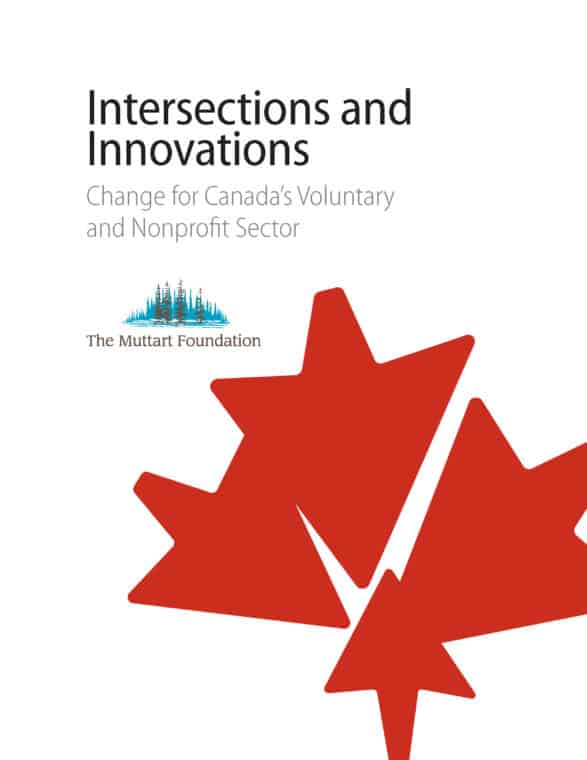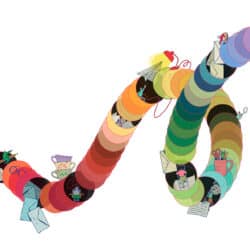Susan Phillips, a professor in Carleton University’s School of Public Policy and Administration, and Bob Wyatt, executive director of The Muttart Foundation, are the editors of the comprehensive Intersections and Innovations: Change for Canada’s Voluntary and Nonprofit Sector, a free online resource published by Muttart.
It’s been an unimaginable year for the charitable and non-profit sector in Canada – to say the least.
For those looking for guidance in a rapidly changing environment, there is now an expansive new resource, Intersections and Innovations: Change for Canada’s Voluntary and Nonprofit Sector, edited by Dr. Susan Phillips and Bob Wyatt.
Phillips, a professor in the School of Public Policy and Administration at Carleton University, and Wyatt, the executive director of The Muttart Foundation in Edmonton, intended the book to be a “living document,” one that can be constantly updated and added to in the coming years.
The book, available online, sits at the crossroads of the sector – spanning all sizes, services, and financial models of charities and non-profits – and features 36 chapters on topics ranging from public policy advocacy and social media to fundraising and board governance.
Shortly after the book’s digital publication, The Philanthropist Journal spoke with Phillips and Wyatt about their collaboration, the book, and where they see the sector headed post-pandemic.
You started working on this book before the world was turned upside down with the COVID-19 pandemic. What was the catalyst to get the project going?
Phillips: A goal we both shared – but as an academic, this was particularly acute for me – was to bring together a community of scholarship. The scholarship on non-profits and philanthropy is underdeveloped in Canada, but it did exist. However, it was fragmented, it wasn’t visible, and it wasn’t as connected to practitioners as it could be.
Part of the goal was trying to identify leading scholars, both very established and emerging scholars, from many different institutions, as well as some of the thought leaders already working in the sector – and to bring them together. We’re trying to not only produce the book, but to show the value of a community of scholarship that’s engaged with the issues of the day.
We’re trying to show the value of a community of scholarship that’s engaged with the issues of the day.
Susan Phillips
Wyatt: Our board decided that we wanted to create an online text, that would be freely available, that looked at the sector in a more holistic way than individual articles did. There were articles about the Canadian charitable sector, but academic articles about the sector were about the US, England, and Australia.
I sat down with Susan and said, “We want to do this – are you on as editor?” And she blew me away by saying, “Well, yes, but you’re going to be the co-editor.” So that was the origin of the project.
In the book, you talk about the difficulty in defining “the sector.” But you also cite a statistic that 1% of organizations account for 80% of total revenues. There’s a lot of diversity within the sector – revenue, size, purpose, and so on. Who is the intended audience for the book?
Wyatt: There are audiences, plural. The academic community is one of the audiences. The sector is an audience. There’s a lot of very practical information in there, from trends in fundraising to governance. The general public that wants to know more about the sector now has one resource they can go to. And certainly one of the audiences is students.
Phillips: Your questions about the sector: we wanted to set the terrain. But we also didn’t want to go around in an endless circle of “What’s the sector? What do we call it? How do we define it?” We wanted to move beyond that debate. We wanted to have data. We wanted to get into issues and look forward and not just tread the same old ground. We really meant it to be innovative.

There are contributions from 52 authors in this book, with three dozen chapters each addressing a different topic. Can you distill all this down into what you see as a couple of key themes that help to advance the understanding of the sector?
Wyatt: My flippant answer is it should demonstrate to people that once you’ve seen one charity … you’ve seen one charity. There’s a broad diversity – and the thing they have in common is existing for a public benefit. At a time in our world where we have increased evidence of fear of others, or even hatred of others, this publication focuses on a significant number of organizations that exist for the sole purpose of helping others.
At a time where we have increased evidence of fear of others, or even hatred of others, this publication focuses on organizations that exist for the sole purpose of helping others.
Bob Wyatt
Phillips: I certainly agree with that. The common theme is that no matter where you’re situated in the sector, so much is in flux. It was before the pandemic, and it’s been accelerated: in terms of leadership and governance models, in terms of financing, and in terms of relationships with the corporate sector, other parts of the sector, and governments.
The need to be reflective – and to have a good understanding of how to address some of those big changes underway – is now even greater post-pandemic.
You cite a statistic that one in five charities is likely to close permanently because of the pandemic and that about 70% of charities and non-profits suffered revenue losses. Add to that some policy uncertainty and heightened interest in impact investing. What do you think the book will contribute at this time?
Wyatt: I think it provides an opportunity for reflection within the sector. Reverting to what was the status quo is not an option for a whole variety of reasons. The publication provides a good resource for practitioners and their boards to begin thinking about what their new future is, individually and as part of a collective.
I have no idea what the sector is going to look like 10 years from now, but I think it will look a lot different than it did 10 years ago. I’m also hopeful that there are portions of the book that will lead policy-makers and academics to become more aware of and engaged with the sector.
You say it’s too early to say how philanthropy will respond in the years to come, but do you have any predictions, or advice, for the sector and the people trying to navigate the next few years?
Phillips: In some ways I’m fairly hopeful. COVID-19 coincided with racial justice movements and questions about structural inequalities in our society. We have a new generation of leaders – assuming this sector can keep them and develop talent so that they move into leadership positions. They see things in different ways, and we’ll be able to meet challenges in different ways.
For a whole variety of reasons, going forward will not be a reflection of the past.


